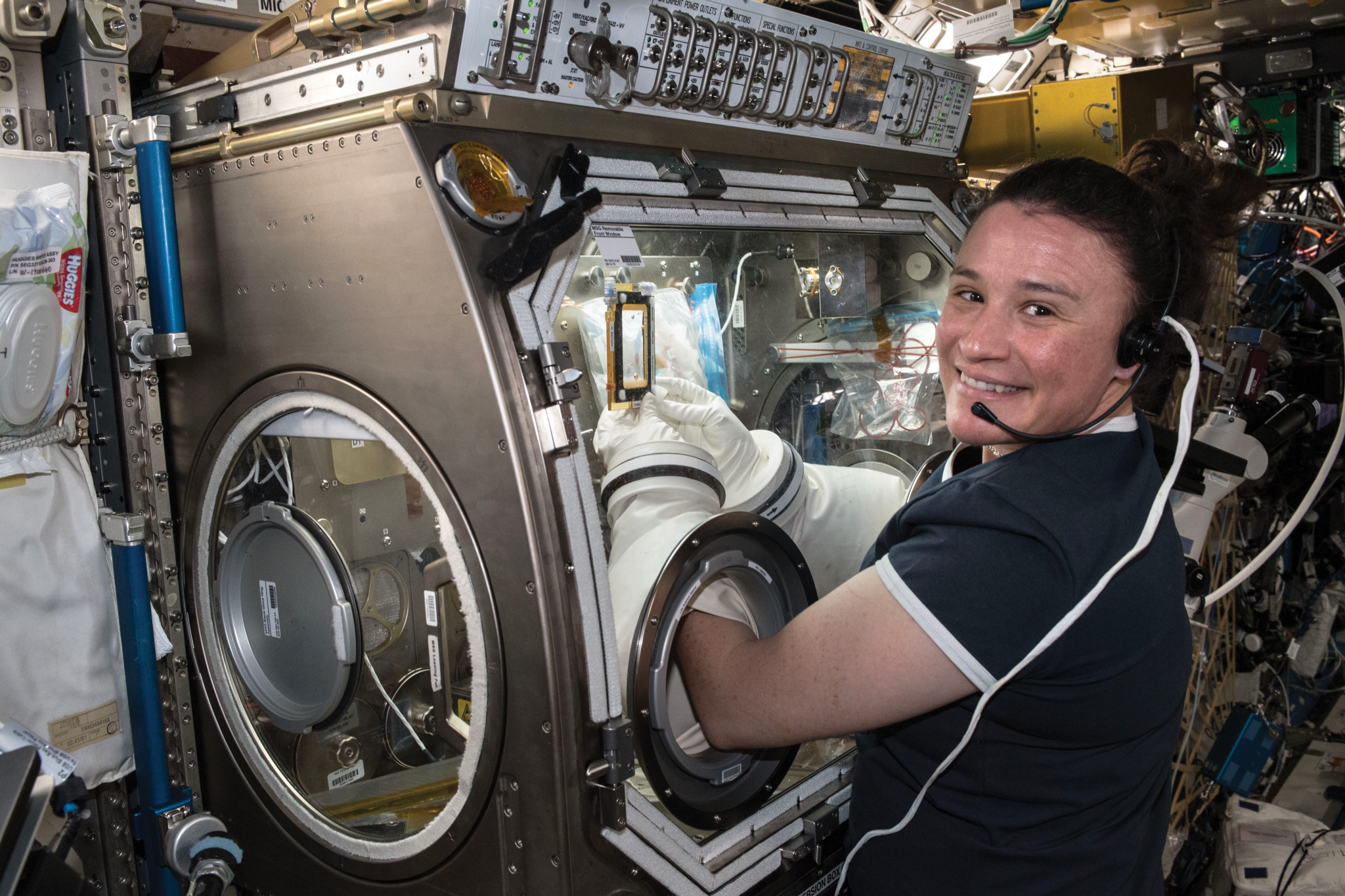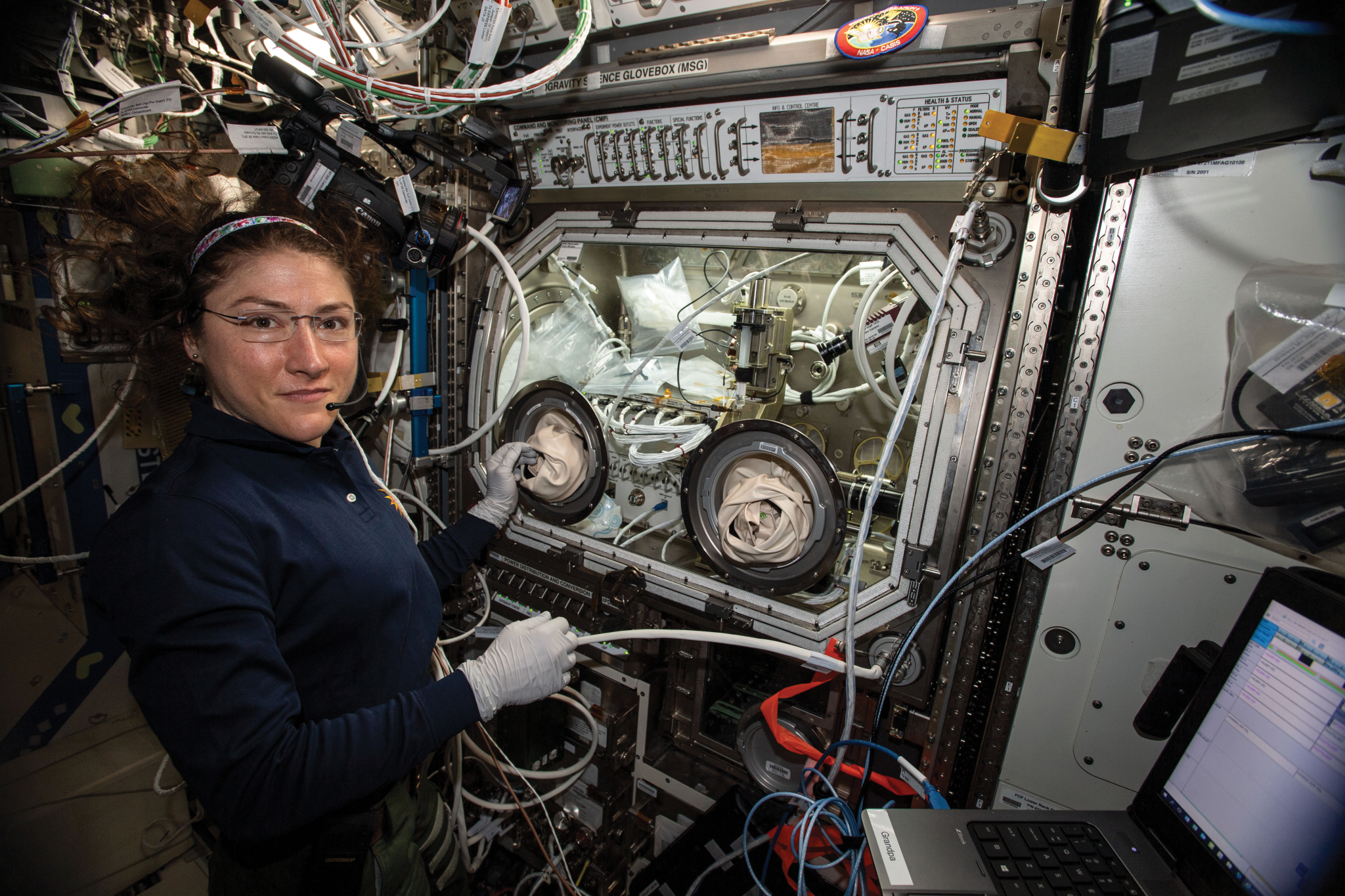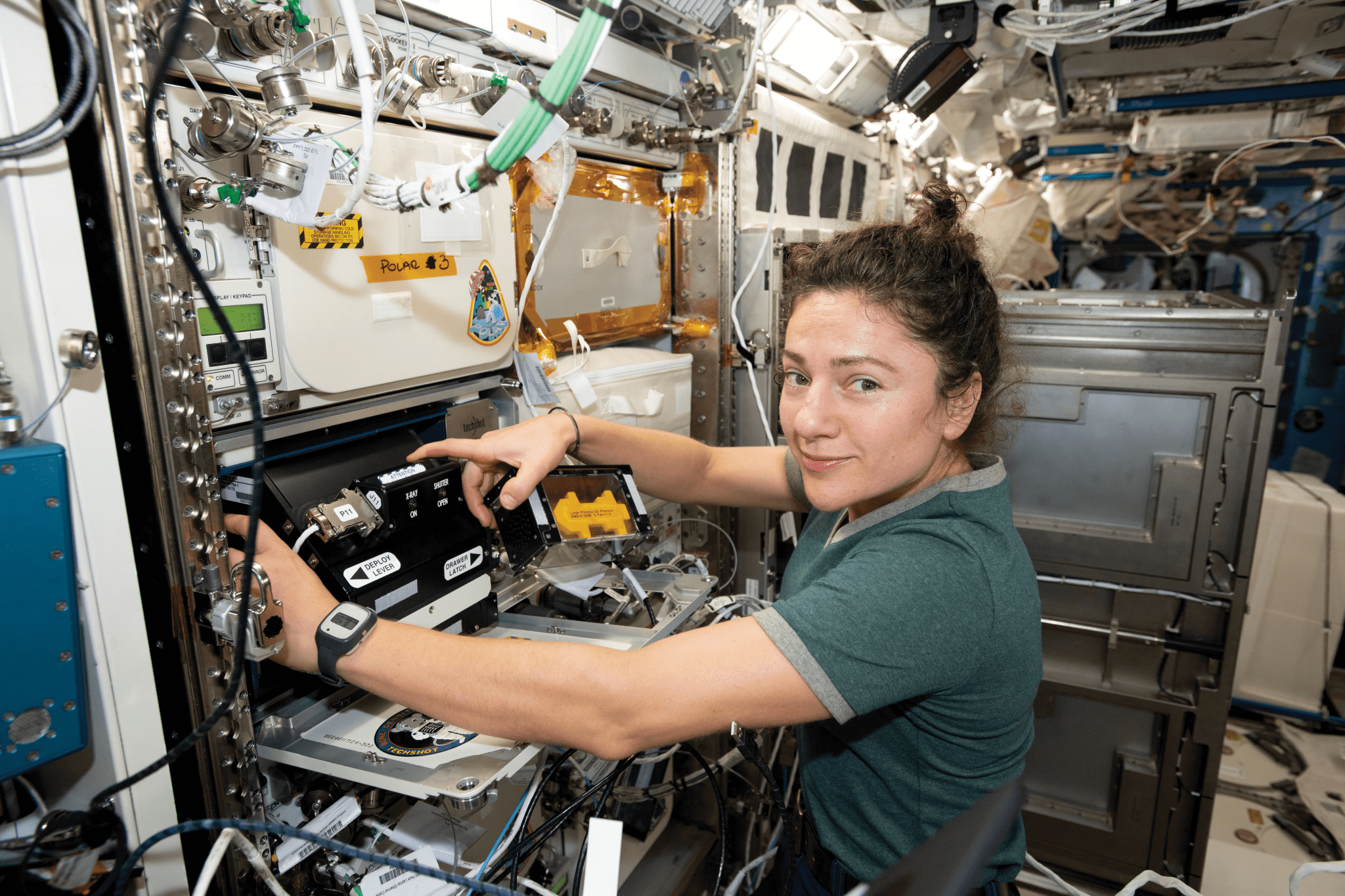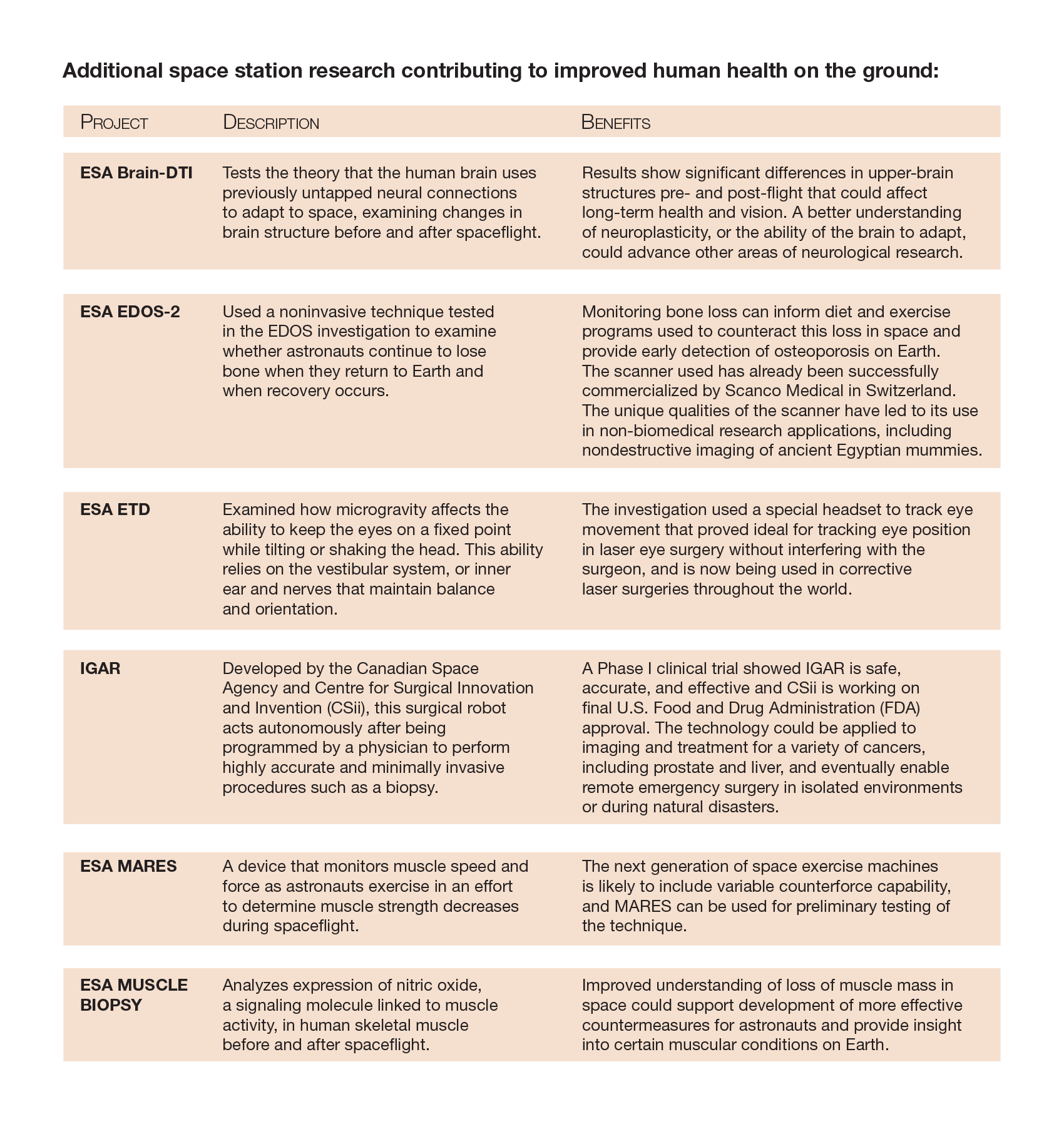As a cup of water sits on the corner of a desk, gravity pulls the liquid down. The walls of the cup push back, keeping the water in place. Those of us living on Earth hardly give a second thought to these forces, but for scientists working to unravel the mysteries of disease, the effects of gravity and the forces of containers on scientific samples may alter experimental results and hinder breakthrough discoveries.
NASA’s Ring Sheared Drop experiment is helping overcome this hurdle. Researchers developed a device for use aboard the International Space Station that uses surface tension to contain the liquid rather than a solid container, something possible only in microgravity.
The aim of this research was to create protein aggregations called amyloid fibrils. These fibrils form a waxy plaque in the brain believed to destroy neurons, a possible cause of Alzheimer’s disease. The study confirmed that the surface tension concept worked. This ability to process materials without containers in microgravity benefits other experiments, including those that grow protein crystals and microorganisms as well as studies of pharmaceutical manufacturing.
Ring Sheared Drop is one of many investigations on the space station that have examined the causes, progression, and treatment of a variety of diseases, and have explored basic mechanisms of human physiology.
A new way to look at Alzheimer’s
Researchers from around the world use the space station to address complex human health problems on Earth. Studies examining the formation of amyloids started after evidence suggested similarities between their formation and protein crystallization, a process already extensively studied in space.
In preparation for the station experiment, Ring Sheared Drop hardware also was tested on parabolic flights in a collaboration between the Rensselaer Polytechnic Institute in New York and researchers from NASA’s Marshall Space Flight Center in Huntsville. These experiments tested and verified novel concepts to accommodate fluid attachment to the metal rings for the space station experiment. In addition, the team plans to use results from these tests in designing additional investigations on the space station. In a ground-based lab, similar results were achieved using a drop of silicone oil in water (rather than a drop of liquid surrounded by air) to account for the effects of gravity. This approach does, however, introduce instabilities probably not present in microgravity.
“So, we were able to simulate microgravity in one respect and make a ring sheared drop at the same scale in the lab as in space,” says principal investigator Amir Hirsa of the Rensselaer Polytechnic Institute. “But the protein solution we sent to space is many orders of magnitude more viscous. So, you can match some but not all aspects of the space experiment. No surprise, heaven and Earth are not interchangeable: there is just no replacement for microgravity.”
The Ring Sheared Drop device pins a drop of liquid between two rings and rotates one while keeping the other stationary to create shear flow, or a difference in velocity between adjacent liquid layers. Previous research shows that this shear flow plays a significant role in the early stages of amyloid formation. Creating the phenomenon is, therefore, an essential feature of the device, Hirsa explains. Other researchers already are using the method to examine actual transport of amyloid plaque in the brain, and it could ultimately benefit development of pharmaceuticals. “Our study may inform drug development, looking at how plaque can be transported out, and whether its transport causes more harm than good.”
Hirsa notes that drugs for removing amyloid plaque from the brain have already been developed. “The idea of transport or flow of amyloid fibrils from a diseased brain is not a pipe dream, it is a focus of pharmaceutical research,” he says. “Our work is one brick in a very large wall.”
The Japan Aerospace Exploration Agency (JAXA) Amyloid study and the Amyloid Aggregation study, a collaboration between the Italian Space Agency (ASI) and ESA (European Space Agency), also analyzed amyloid fibrils formed in microgravity. Amyloid results published in 2020 reveal that fibrils form distinct structures and grow more slowly in microgravity, making the space station an ideal environment for detailed analysis of the mechanisms of how they form. Such analysis also could contribute to the development of new pharmaceuticals aimed at inhibiting amyloid fibril formation.
Breathing easier in space and on Earth
Research aimed at protecting the lungs and airways of astronauts is helping people with asthma and other breathing issues on Earth. For ESA’s Airway Monitoring study, which builds on results from earlier NOA-1 and NOA-2 experiments conducted aboard the International Space Station, researchers at Sweden’s Karolinska Institute collaborated with medical technologists and developed an instrument that measures exhaled air for nitric oxide. Clinics and hospitals already use the device as a quick, low-cost tool to help diagnose inflamed lungs and asthma, and testing the technique in space adds data for improving its use on Earth.
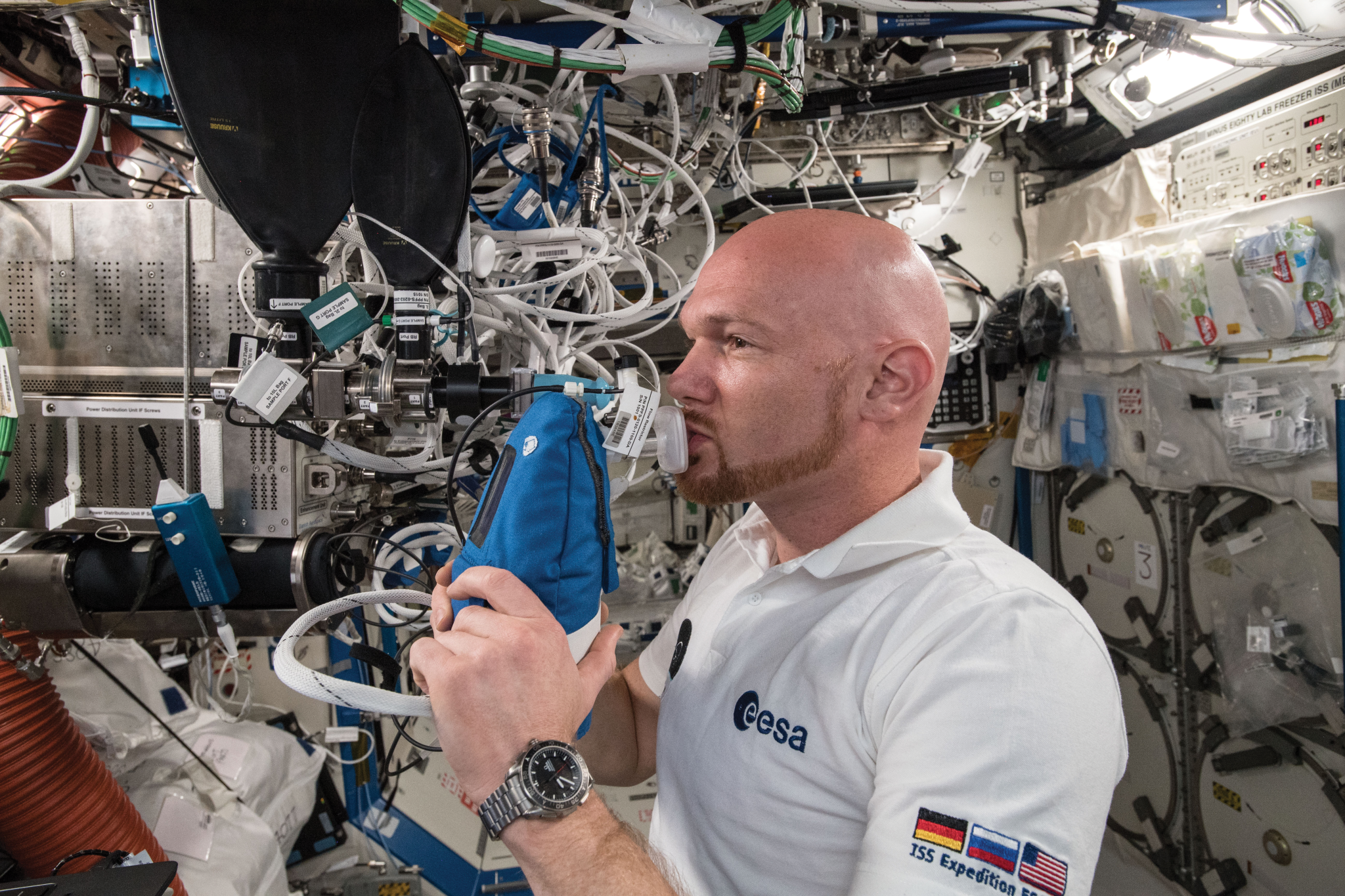
Astronauts breathed into the device in the reduced pressure of an airlock to simulate conditions in future habitats on the Moon or Mars. Lead investigator Lars Karlsson of Sweden’s Karolinska Institute hopes that the experiment opens new fields of research in reduced pressure in space. Exhaled nitric oxide measurements also could be used to identify the most effective molecules for use in drugs to treat inflamed airways and lungs.
“One group of experiments that I enjoy most are those where we investigate our own human systems to help people with illnesses on Earth,” says ESA astronaut Alex Gerst, who participated in the Airway Monitoring investigation. “It’s another example of how we need to fly to space to help people down here.”
Toward better cancer treatments
Cancer is a leading cause of death in the United States, accounting for hundreds of thousands of deaths each year. The International Space Station National Laboratory is advancing cancer research through studies that cultivate stem cells for possible therapeutic applications, crystallize proteins for improved drug discovery and delivery, and test therapies to find those that work better or have fewer side effects. Other projects seek to improve 3D cell culturing for more accurate drug testing that could reduce the failure rate of current drug discovery efforts.
Angiex, Inc., of Cambridge, Massachusetts, developed a treatment targeting the blood supply of tumor cells, which kills cancer cells by depriving them of oxygen and nutrients. The company’s Angiex Cancer Therapy investigation took advantage of the space station’s microgravity environment to culture endothelial cells, which line the walls of blood vessels, to see whether they might provide a valid model to help develop safer and more cost-effective cancer treatments.
“When scientists try to grow endothelial cells on the ground, they don’t live for very long. One of the things we tested on orbit is whether the cells grow better in space,” says NASA astronaut Serena Auñón-Chancellor. “Endothelial cells help provide blood supply, and tumors need blood supply to get bigger. If we can stop that tumor blood supply from growing, then we can help beat that cancer. All of us have had someone affected by cancer, whether a family member or friend, and we’re always thinking of how we can fight it. One way is if we can grow these cells on orbit and use them to test new drugs that can prevent that blood supply from growing.”
Angiex is only one of many investigations on the space station seeking better treatments for cancer.
Endothelial Cells, an ESA experiment that examined how cultured endothelial cells react to spaceflight, made modifications to the culturing hardware that can be put to use by these types of biomedical experiments in space.
Insight into the immune system
Astronauts experience impaired immune function in space. Impaired immune response also happens with aging on Earth. Space offers a unique advantage to studying this aging-related immune suppression since conditions that normally develop over decades happen quickly there. A growing body of research takes advantage of this fact.
ESA’s Leukin-2 experiment demonstrated that microgravity has a fundamental effect on activation of T-cells, which are involved in turning on and off the immune system. Control samples also flew to the space station and were cultured in a centrifuge to simulate normal gravity to eliminate the effects of factors such as the stress of launch and increased radiation exposure in space.
“We were able to look specifically at what microgravity is doing to the cells,” says Tammy T. Chang, a researcher at the University of California, San Francisco, and an author on several papers related to Leukin-2. “This study added an important piece of information to immune dysregulation seen in astronauts: that the cells themselves are sensitive to the presence or absence of gravity on a molecular level.”
The same mechanisms may be behind immune dysregulation on Earth. “Researchers may be able to use microgravity to enhance self-assembly of complex tissues to study various human diseases,” Chang says. Ultimately, this type of research could lead to drugs that turn up the immune response for immunosuppressed patients or turn it down to treat autoimmune or inflammatory disease.
Another ESA investigation, Immuno, also observed T-cell changes in space. Increased understanding of how stress affects the immune system could help people on Earth as well as support development of drugs to counter immune system changes for long-duration spaceflight.
Protecting muscles and bones
The ISS National Lab sponsored Mighty Mice in Space investigation showed that blocking a specific molecular signaling pathway involved in maintaining muscle and bone protected astronauts against bone and muscle loss in microgravity, and even stimulated growth. Results suggest that this strategy could prevent and treat such loss in people on Earth as well.
“A key take home is that blocking this pathway, which we knew would be effective in stimulating increased bone and muscle mass on Earth, is just as effective in microgravity,” says principal investigator Se-Jin Lee at The Jackson Laboratory for Genomic Medicine in Connecticut. He explains that a number of drug candidates targeting this pathway already have been developed and tested in clinical trials, with mixed results. “One trial showed promising results, but the drug needs to be tweaked to avoid side effects. There is still a fair amount of work to be done to pursue this strategy for treating muscle loss. We have some amazing data on the magnitude of the effect on the ground and in space and hope it will stimulate a lot of drug development activity.”
Increasingly, researchers from companies small and large, institutions, government agencies, and other organizations leverage microgravity to address complex human health issues on Earth. By providing a platform for long-term microgravity research, the space station fosters breakthroughs that yield direct benefits to people on Earth. Remove gravity from the equation and we can see out-of-this-world breakthroughs.























